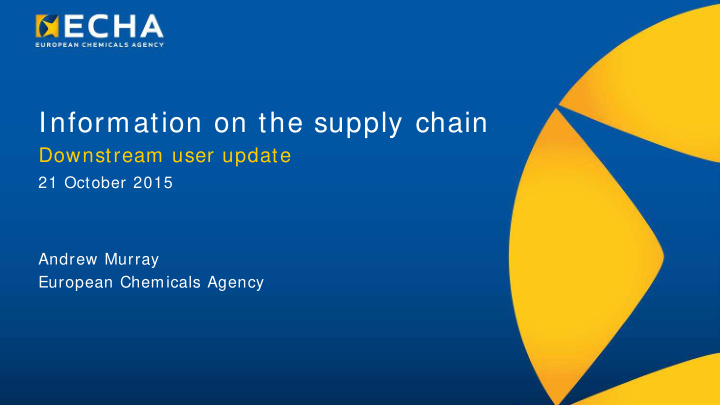



Information on the supply chain Downstream user update 21 October 2015 Andrew Murray European Chemicals Agency
Contents • Vision on how information in the supply chain works. • Tools that help with effective supply chain communication. • What’s available now and in near future • Mixtures. • Sources of information on chemicals: • Finding information on chemicals • Databases • Dissemination web page: InfoCard and Brief Profile. • Useful links. 2
The chem ical supply chain
Com m unication flow in the supply chain 4
Com m unication in the supply chain 5
Com m unication in the supply chain • Better information to suppliers results in better advice on safe use from suppliers. • If you have new information on • hazards or • inappropriate risk management measures in the safety data sheet You m ust communicate it to your supplier. 6
Form ulators Formulators produce mixtures, which are usually supplied further downstream • Examples of mixtures: paints, lubricants, cleaning agents and adhesives …are dow nstream users under REACH and CLP 7
Com m unication in the supply chain I NFORMATI ON FOR REGI STRANTS 8
Upstream com m unication • Several industry organisations have developed Sector Use Maps for registrants to use Sector use m aps • Act now to include uses for substances that are to be I NFORMATI ON FOR registered in 2018 REGI STRANTS 9
The supply chain I NFORMATI ON FOR REGI STRANTS 10
Harm onisation and structure of exposure scenario • Consistent format for the exposure scenario. ToC • Efficiency through harmonisation and an IT exchange standard, ESCom package. • Standard phrases – less variability in the information; more relevant and understandable. • Table of Contents (ToC) in SDS, easier to identify the exposure scenarios Standard relevant for you. phrases 11
The supply chain I NFORMATI ON FOR REGI STRANTS 12 12
Form ulating m ixtures for end users Supplier 2 Substance A Supplier 3 Supplier 1 Substance B Substance A Mixture C W hat to com m unicate and how ? Mixture D ( = A+ B+ C) 13
W hat to com m unicate - Bottom up approach 1. Existing conditions of safe use 3 are identified within sectors 2. Provided as S afe U se of M ixtures I nformation (SUMI) 1. Harmonised template 2. Uses clear language, pictograms, in 2 sector terminology 3. Formulator cross checks that use is covered by supplier ES 1 14
Safe Use of Mixture I nform ation ( SUMI ) NOTE: This format is still subject to (minor) editorial changes. 15
W hat to com m unicate – Top dow n approach 1. Lead component for various routes of exposure is identified (methodology under development by industry 1 sectors) 2. This identifies which OC/ RMMs to 2 communicate 3. This is communicated as safe use 3 information on mixture 16
I m proving com m unication in the supply chain • CSR/ ES Roadmap • stakeholder plan of action • Exchange Network on Exposure Scenarios (ENES) • collaborative network • companies, sector associations, authorities 17
Sources of inform ation on chem icals
Sources of inform ation on chem icals • Finding information on chemicals • Databases • (New) Dissemination web page 19
Finding inform ation on chem icals W hat is it used for? How is it classified? Likely to be restricted? http: / / www.echa.europa.eu/ information-on-chemicals 20
Substance inform ation on the ECHA w ebsite 21
Databases on ECHA w ebsite • Registered Substances • > 13,000 substances registered • C&L inventory • > 120,000 substances notified • Regulatory status (authorisation, restriction etc) • Databases from other regulations (Biocidal Products Regulation (BPR), Prior Informed Consent (PIC)) • Information from previous chemicals legislation http: / / echa.europa.eu/ information-on-chemicals 22
I nfoCard ( new 2 0 1 5 ) High-level information to concerned citizens Understandable to the broadest audience possible Information on hazards, classification, uses & exposure Overview of main regulatory activities Information in downloadable format
Brief Profile Substance description Extended information on substance identity Overview of Classification and Labelling inventory Information on manufactures and suppliers Links to the source data
Brief Profile Scientific properties Physical-chemical properties Environmental fate and pathways Ecotoxicological information (including PNEC) Toxicological information (including DNEL) Study records type overview Information in downloadable format
How inform ation from REACH/ CLP can help chem icals be used m ore safely Exposure scenarios – improvements are being made in content, format and automation Formulators – they are playing a vital role in communicating the relevant information in an understandable way Information in the supply chain – what goes up, comes down Information from REACH/ CLP – a lot is available on ECHA website to help environmental, health and safety activities Follow the developments: echa.europa.eu/ csr-es-roadmap 26
Useful links • CSR/ ES Roadmap • Developing solutions to supply chain issues. • http: / / echa.europa.eu/ regulations/ reach/ registration/ information- requirements/ chemical-safety-report/ csr-es-roadmap • Exchange Network on Exposure Scenarios • Exchange on good practice • http: / / echa.europa.eu/ web/ guest/ about-us/ exchange-network-on- exposure-scenarios • Downstream user web pages • http: / / echa.europa.eu/ regulations/ reach/ downstream-users 27
Thank you! andrew.murray@echa.europa.eu Subscribe to our news at echa.europa.eu/ subscribe Follow us on Twitter @EU_ECHA Follow us on Facebook Facebook.com/ EUECHA
Recommend
More recommend